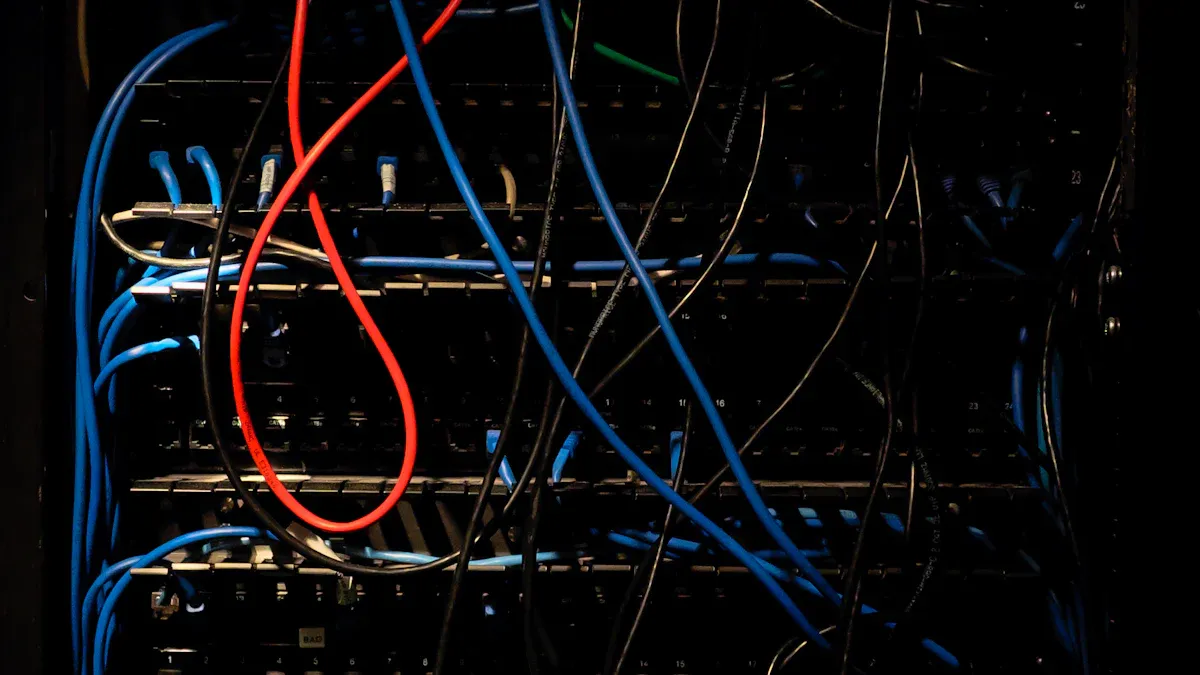
Cloud providers face increasing demands for reliable and efficient power management. Modular PDUs address these challenges by offering flexible and scalable solutions. They enable seamless expansion of power distribution systems without significant overhauls. With data production expected to exceed 2,100 zettabytes by 2025, the need for dependable Power Distribution Units has never been greater. Additionally, high-efficiency transformers in modular PDUs improve energy efficiency by up to 3%, helping data centers reduce operational costs and achieve up to 20% energy savings.
Key Takeaways
- Modular PDUs are flexible and can grow with needs. They help cloud providers add power without big changes.
- Using energy-saving modular PDUs can save a lot of money. Energy costs might drop by as much as 20%.
- Checking and updating modular PDUs often makes them work better. This keeps data centers running without problems.
Understanding Modular PDUs
What are modular PDUs?
Modular PDUs are advanced power distribution units designed to provide flexibility, scalability, and efficiency in managing power within data centers. Unlike traditional PDUs, modular systems allow operators to dynamically reconfigure power distribution without requiring extensive hardware changes. This adaptability makes them ideal for high-density environments where power demands frequently fluctuate.
📌 Note: A 2023 survey revealed that 67% of North American data center operators prioritize modularity in PDU selection, a significant increase from 42% in 2020.
Key components and functionalities
Modular PDUs consist of several key components that enhance their functionality and reliability. The table below outlines these components and their roles:
| Component | Functionality |
|---|---|
| Power Modules | Enable dynamic addition or removal of capacity without disrupting operations. |
| Intelligent Monitoring | Tracks power usage in real-time, optimizing energy efficiency. |
| Hot-Swappable Features | Allow maintenance or upgrades without system downtime. |
| Environmental Sensors | Monitor temperature and humidity to prevent overheating. |
These features align with modern data center requirements, ensuring seamless integration and operational efficiency.
Benefits for cloud providers
Cloud providers benefit significantly from modular PDUs due to their adaptability and efficiency. These systems support scalability by allowing the addition of power modules as demand grows. Hyperscale operators like AWS and Microsoft have adopted modular PDUs to manage rack power densities exceeding 25 kW in AI-driven environments. Additionally, modular PDUs optimize energy usage, helping data centers achieve sub-1.2 PUE ratios, which reduces operational costs.
The ability to service individual modules without affecting the entire system enhances reliability and minimizes downtime. This feature is particularly valuable in maintaining uninterrupted operations in mission-critical environments.
Selecting the Right Modular PDU Configuration
Assessing power capacity and load requirements
Determining power capacity and load requirements is critical for selecting the right modular PDU. Cloud providers must evaluate the number of cabinets, power demand per cabinet, and total energy needs. For instance, a data center with 40 cabinets, each requiring 5 kW, would need a total capacity of 200 kW. Backup systems should exceed this by at least 10%, ensuring reliability during peak loads.
| Component | Value |
|---|---|
| Number of cabinets | 40 |
| Power requirement per cabinet | 5 kW |
| Total energy requirement | 200 kW |
| Backup UPS line capacity | 222.22 kW |
| Maximum occupancy rate | 90% |
| Uptime Tier | Tier 3/Tier 4 |
| Uptime percentage | 99.982%/99.995% |
This data-driven approach ensures that modular PDUs meet both current and future demands.
Ensuring scalability for future growth
Scalability is a cornerstone of modular PDU design. These systems allow operators to add power modules as demand increases, avoiding costly overhauls. Modular designs also support adaptability, enabling seamless integration with evolving technologies. This flexibility is essential for cloud providers managing rapid growth in data traffic and workloads.
Compatibility with existing infrastructure
Modular PDUs integrate seamlessly with existing infrastructures, offering flexibility and customization. Operators can adjust power capacity without disrupting operations, ensuring efficiency and cost-effectiveness. Smart PDUs enhance compatibility by providing real-time monitoring and environmental sensors. These features optimize performance and maintain uptime, making them indispensable for modern cloud environments.
Energy efficiency and sustainability considerations
Energy efficiency and sustainability are vital for reducing operational costs and environmental impact. High-efficiency transformers in modular PDUs improve energy usage by 2% to 3%, leading to significant savings. Features like real-time power monitoring and load balancing minimize waste and support green initiatives. A global technology company achieved a 20% reduction in energy costs by leveraging intelligent PDUs, demonstrating their value in sustainable operations.
💡 Tip: Investing in energy-efficient modular PDUs not only reduces costs but also aligns with sustainability goals, enhancing a company’s reputation in the industry.
Exploring Types and Features of Modular PDUs

Basic vs. intelligent modular PDUs
Basic modular PDUs provide essential power distribution capabilities. They are reliable and cost-effective but lack advanced features. Intelligent modular PDUs, on the other hand, offer enhanced functionalities such as real-time monitoring, remote management, and environmental sensing. These features allow operators to optimize energy usage and improve operational efficiency. Intelligent PDUs are particularly beneficial for cloud providers managing high-density environments, as they enable precise control over power distribution.
Advanced features like remote monitoring
Remote monitoring is a game-changer for data center operations. It allows operators to track power usage, identify issues, and make adjustments from any location. This capability reduces the need for on-site intervention, saving time and resources.
- A survey of IT managers reported a 40% improvement in maintenance response times for data centers using remote monitoring.
- Automation and remote management enhance efficiency by minimizing manual tasks.
- Operators can ensure uninterrupted operations by controlling power distribution remotely.
Environmental sensors for data center optimization
Environmental sensors integrated into modular PDUs monitor temperature, humidity, and airflow. These sensors help prevent overheating and optimize cooling systems.
- Research shows that AI-driven environmental monitoring can improve energy efficiency by 15-20%.
- Data centers using PDUs with sensors achieve 10-15% savings in cooling costs, reducing overall operational expenses.
Hot-swappable components for reduced downtime
Hot-swappable components in modular PDUs allow maintenance or upgrades without disrupting operations. This feature ensures continuous uptime, which is critical for cloud providers. For example, the Vertiv Geist rPDU includes a hot-swappable network interface module, enabling seamless maintenance. By preventing costly disruptions, hot-swappable components significantly reduce downtime and enhance reliability.
Configuring Modular PDUs for Cloud Providers

Evaluating current and future power needs
Cloud providers must assess both current and anticipated power requirements to ensure uninterrupted operations. Large data centers consume between 20 MW and over 100 MW of power, with global data center energy consumption rising by 55% from 2022 to 2023. Operators can use statistical assessments to determine capacity at rack, row, and room levels.
- Rack-level capacity determination evaluates power and cooling needs for individual racks.
- Row-level capacity determination identifies requirements for rows of racks, enabling precise planning.
- Room-level capacity determination ensures the entire facility supports equipment without overloading.
Real-time monitoring, load balancing, and capacity planning further enhance efficiency. These metrics allow operators to forecast future workloads and optimize energy usage.
| Metric | Description |
|---|---|
| Real-time monitoring | Tracks power consumption at various levels, aiding immediate adjustments and efficiency. |
| Load balancing | Distributes power evenly across systems to prevent overloads and ensure optimal performance. |
| Capacity planning | Forecasts future power needs based on current and anticipated workloads. |
| Energy efficiency measures | Implements strategies to reduce energy consumption and costs, enhancing sustainability. |
Designing an efficient PDU layout
An efficient modular PDU layout ensures scalability and adaptability in dynamic cloud environments. Modular designs allow flexible capacity adjustments and streamlined deployment. Customizable configurations meet specific workload demands while minimizing downtime during maintenance.
| Trend | Description |
|---|---|
| Modular Designs | Adapt to dynamic environments, allowing scalability without overhauls. |
| Energy-Efficient Features | Reduce power consumption and carbon footprints, aligning with sustainability goals. |
| AI Integration | Enhances predictive maintenance and energy management for optimal performance. |
| Sustainability Focus | Promotes eco-friendly practices and reduces energy waste. |
Implementing remote management tools
Remote management tools empower IT administrators to control power distribution and outlet switching from any location. Automation reduces manual intervention, saving time and resources. Live data monitoring streamlines processes with intelligent reporting, ensuring quicker responses to issues.
| Feature | Benefit |
|---|---|
| Automation | Reduces manual intervention, saving time and resources. |
| Remote Management | Allows control from anywhere, minimizing downtime. |
| Live Data Monitoring | Streamlines monitoring processes with intelligent reporting. |
These tools enhance operational efficiency and reliability, making them indispensable for cloud providers managing high-density environments.
Compliance with industry standards
Compliance with industry standards ensures modular PDUs meet safety, efficiency, and environmental requirements. Certifications like ISO9001 and UL guarantee consistent manufacturing and electrical safety. RoHS and CE focus on reducing environmental impact and verifying performance.
| Compliance Aspect | Details |
|---|---|
| Energy Efficiency Directive | Mandates a 40% reduction in energy use for data centers by 2030. |
| Adoption of New PDUs | 68% of new PDUs sold in Europe include features for energy compliance. |
| ASHRAE Standards | Emphasize adaptive cooling and precision power distribution. |
| Tropical Data Center Standards | Require PUE thresholds below 1.6 for faster deployment of efficient PDUs. |
| Cost Dynamics | Energy-efficient PDUs cost 12-18% more upfront but deliver ROI within 22 months. |
By adhering to these standards, cloud providers can optimize performance while meeting sustainability goals.
Future-Proofing Modular PDU Investments
Preparing for emerging technologies
The rapid evolution of cloud computing and data center technologies demands future-ready modular PDU systems. The global cloud computing market, projected to reach $832.1 billion by 2025, highlights the growing need for efficient power distribution solutions. Modular PDUs equipped with IoT capabilities enable real-time monitoring, optimizing energy usage and improving sustainability. AI and machine learning integration further enhance these systems by enabling predictive analytics, which minimizes downtime and extends equipment lifespan.
| Technology | Impact on Modular PDU Systems |
|---|---|
| IoT | Enables real-time monitoring and management of power consumption, optimizing energy usage and improving sustainability. |
| AI and Machine Learning | Facilitates predictive analytics for proactive maintenance, minimizing downtime and extending equipment lifespan. |
| Modular Designs | Allows for easy expansion as power needs grow, reducing installation time and costs for rapidly evolving industries. |
By adopting modular designs, cloud providers can scale their infrastructure seamlessly, ensuring flexibility and cost-effectiveness in dynamic environments.
Regular maintenance and upgrades
Regular maintenance ensures optimal performance and longevity of modular PDUs. Built-in meters in modern PDUs enable continuous monitoring of power quality, helping operators identify and address issues like voltage dips before they escalate. Proactive monitoring enhances safety and stability through proper grounding and isolation, which are critical for effective power management.
- Continuous monitoring detects power interruptions early, preventing system failures.
- Proper grounding and isolation improve safety and reliability.
- Scheduled upgrades ensure compatibility with emerging technologies, extending the lifespan of the equipment.
Routine maintenance not only reduces downtime but also enhances operational efficiency, making it a vital practice for cloud providers.
Partnering with trusted manufacturers
Collaborating with experienced manufacturers ensures access to high-quality, customized modular PDU solutions. Companies like YOSUN, with over 25 years of expertise, deliver innovative products such as Smart PDUs and Heavy Duty PDUs. These solutions integrate seamlessly with Data Center Infrastructure Management (DCIM) systems, providing real-time data on power consumption.
In one case, a global technology company achieved a 20% reduction in energy costs and improved uptime reliability by implementing intelligent PDUs. Trusted manufacturers also offer tailored solutions that maximize cost savings and operational efficiency, making them indispensable partners for future-proofing investments.
💡 Tip: Partnering with reliable manufacturers ensures long-term value and adaptability, safeguarding investments against technological obsolescence.
Modular PDUs play a pivotal role in ensuring scalability, efficiency, and reliability for cloud providers. Strategic planning and careful selection maximize their benefits, including cost savings and reduced downtime.
| Benefit | Statistic/Case Study Description |
|---|---|
| Cost Savings | Custom PDUs optimize power management, leading to significant long-term cost savings. |
| Energy Cost Reduction | Organizations reported up to a 20% reduction in energy costs within the first year of adoption. |
| Downtime Reduction | Advanced safety features reduced downtime incidents by 30%, saving $50,000 annually for a mid-sized data center. |
Investing in modular PDUs ensures sustainable growth and operational excellence in an evolving technological landscape.
FAQ
What is the lifespan of a modular PDU?
A modular PDU typically lasts 10-15 years with proper maintenance. Regular inspections and upgrades can extend its operational life.
Can modular PDUs handle high-density environments?
Yes, modular PDUs are designed for high-density environments. They support scalability and provide precise power distribution for racks exceeding 25 kW.
How do modular PDUs improve energy efficiency?
Modular PDUs optimize energy usage through real-time monitoring, load balancing, and high-efficiency transformers, reducing energy waste by up to 20%.
💡 Tip: Regular maintenance and monitoring ensure modular PDUs operate at peak efficiency, maximizing their benefits for cloud providers.



